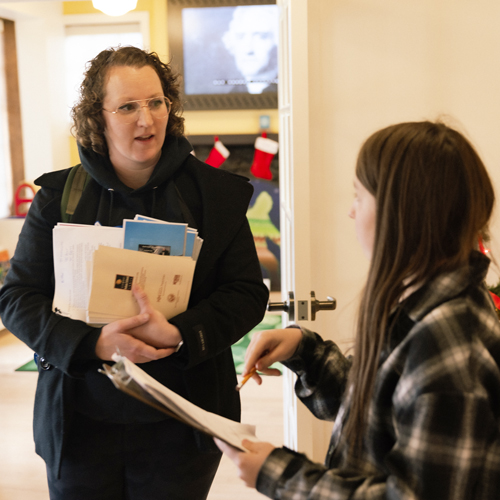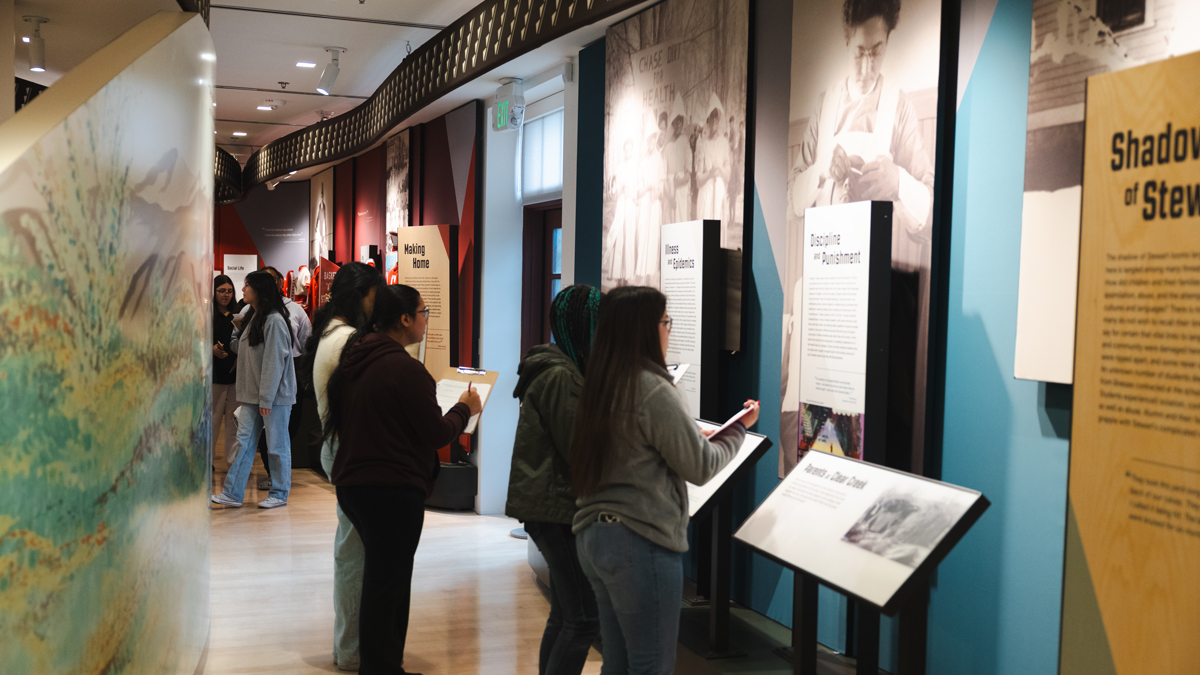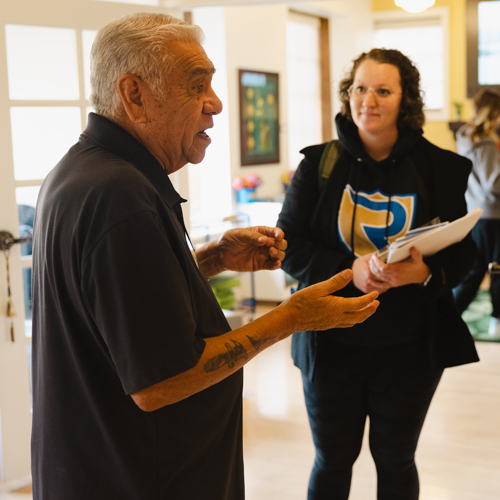University of Nevada, Reno Collegiate Academy students from Edward C. Reed High School piled off school buses in the parking lot of the Stewart Indian School in Carson City, clipboards in hand. Teachers Sonia Kretschmer and Jessica Eichstedt wanted their students to fully immerse themselves in the college-level, credit-bearing history curriculum they were working through in the classroom, and that meant a field trip. In collaboration with University of Nevada, Reno Assistant Professor of History Sarah Keyes, Ph.D., the Collegiate Academy teachers developed a plan for the visit to the Nevada historical site.

Collegiate Academy teacher Jessica Eichstedt speaks with a student inside the Stewart Indian School Museum.
“Our class this year is focused on Nevada history, history in the West and the history of minorities,” Kretschmer said. Students in the dual credit class will earn credits from the University of Nevada, Reno. “We thought it was really important to bring students here because it encompasses all of the themes we are talking about in the Collegiate Academy course, but it’s also just incredibly important for students to see that these aren’t some far-off concepts or things that happened a long time ago and a long ways away. This is something that happened in our own backyard. This is a part of our history and people are still living and affected by this history.”
"Sonia and Jessica really wanted students to grapple with history in a way that was geographically close to them."
The Stewart Indian School is one of over 500 boarding schools set up across the U.S. in the late 19th century with the intention of assimilating Native American children into the dominant Anglo-American culture. Cruel policy gave school officials authority to kidnap children from their families and bring them to boarding schools like Stewart and thousands of families were impacted, contributing to the genocide of Native tribes in the U.S. Native children from over 200 tribal nations attended the school between 1890 and 1980.
Kretschmer and Eichstedt collaborated with Keyes on how to incorporate a field trip into the college-level curriculum in a way that would be academically challenging and personally meaningful for the students.
“Sonia and Jessica really wanted students to grapple with history in a way that was geographically close to them,” Keyes said. “We had quite a bit of content in the course already around Indian boarding schools like the Stewarts Indian School, the traumas of those schools and the ways in which the United States government was trying to forcibly change Native peoples and Native lifeways. Sonia and Jessica were able put together this field trip and give their students a firsthand real-life experience of history.”
Keyes ensures newer research and concepts are incorporated in the regularly updated coursework, keeping it fresh and relevant.
“One of the great strengths of Collegiate Academy is this collaborative approach between the professors at the University of Nevada, Reno and the high school teachers across Nevada,” Keyes said. “I like to structure the courses around five central pieces of historical thinking so that students aren't just getting content knowledge, they're also developing their skills of inquiry and their skills of writing and their skills of analysis. Our course is really designed to grab student’s interest while exposing them to the rigor of a college course. When I think about grabbing students’ interest, this field trip to Stewart Indian School is a great example of that.”

Students explore the Stewart Indian School Museum.
The high school students split into two groups after arriving at the Stewart Indian School, one to tour the free and public museum and one to walk the 110-acre campus grounds marked by stone buildings constructed by Stewart Indian School students and Hopi stonemasons. The sprawling campus is framed by the towering mountains of the Eastern Sierra. At each stop along the campus tour, the teachers would share a story of a former Native American student who had attended the school and their experiences, both positive and negative.

Frank Joe, a member of the Western Shoshone, speaks with students and teacher Jessica Eichstedt about his experience as a 10-year-old student at the Stewart Indian School. You can hear Joe share his story in a video produced by Visit Carson City.
“Boarding school history is an important part of American history and needs to be taught at schools from fourth grade and up, and not just at Nevada schools, but all schools,” Stewart Indian School Museum Director Bobbi Rahder said. “There are over 523 boarding schools in the U.S. for Native children and this federal policy of assimilation caused historical trauma for all Native families who attended these schools. Although the federal policies improved in the 1930s, assimilation was always the goal to teach these students English and vocational skills. It is only toward the end of Stewart’s history that the level of education improved and started to prepare Native students for college. The important takeaway for us at this museum is that we are here to help the Native relatives who attended boarding schools to heal from the historical trauma of being removed from their families. And we want the general public to know that this trauma has been passed down in Native families and is still impacting families today. It’s an important part of understanding that Native people are not victims, but survivors and resilient.”
Inside the museum, students heard from Stewart Indian School alumnus Frank Joe. Joe, Western Shoshone, attended the Stewart Indian School in 1950 at age ten.
“The students’ interactions with the guest speaker who’s an alumnus of the school, hearing from somebody who actually attended the school and had this experience and seeing them respond with awe to that interaction – I could see it was making an impact,” Kretschmer said.
Several of the students expressed that impact.
"The important takeaway for us at this museum is that we are here to help the Native relatives who attended boarding schools to heal from the historical trauma of being removed from their families. And we want the general public to know that this trauma has been passed down in Native families and is still impacting families today."
“Once you are physically in the place where history has been made, you get to see things through the eyes of people who were here during that time in history,” Collegiate Academy student Brenda Medina said. “For example, we got to speak to someone who was here during this time period. I’ve found it all very eye-opening.”
“We learned about assimilation and how it happened, but I get to see how it happened now and it really changed my perspective,” Collegiate Academy student Richard Demuth said. “We had all these pictures [of the Stewart Indian School] and I understood them, but it was a completely eye-opening experience being here. I know that where I’m standing right now, multiple people from the school have walked.”
About the Collegiate Academy experience
The Collegiate Academy is a dual-credit program in which Nevada high school students can take college courses and earn college credits at a discounted rate through the University of Nevada, Reno. Courses are taught in the high schools during the student's regular schedule of classes. Students earn their credits by taking the course as opposed to the more common test-for-credit structure. The credits earned may be seamlessly used at the University of Nevada, Reno or transferred to colleges and universities nationwide and may enable students to graduate from college early.
“I really enjoy this class because it is definitely a different environment,” Medina said. “It also helps me to get the college experience without being suddenly pushed into a college class. It lets me slowly migrate into a college environment which I am really grateful for. I don’t know what I would do if I was a senior suddenly going straight to college.”
Central to the program’s success is collaborations between University faculty and high school teachers on curriculum development.
“The Collegiate Academy has been amazing because it has given us the opportunity to work with professors who have a wide depth of knowledge in what we’re trying to teach our students,” Kretschmer said. “I’ve learned things from Dr. Keyes and through this experience that I didn’t know about US history. Early on in developing the curriculum, she talked about land acknowledgment, she talked about resistance and she talked about historical trauma and generational trauma which is something these Stewart Indian School alumni absolutely experienced. Being able to collaborate with her on molding the curriculum and what we teach our students, and now bringing them here to the Stewart Indian School, has been really great.”
"Teaching the Collegiate Academy class has been transformative in bringing history to life for many of our students by realizing the larger U.S. history and its relevance to the Reno/Sparks area," Eichstedt added. "Bringing the students to the Stewart Indian School provides an opportunity to see the complexity of Nevada's American history and explore how diverse populations have contributed to our surrounding communities to make them what they are today."
The Collegiate Academy dual-credit program is made possible through a partnership between the University and school districts throughout Nevada.














